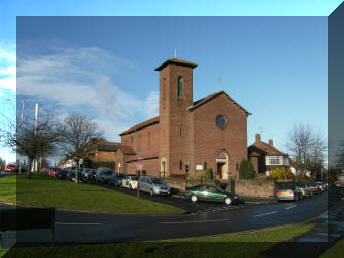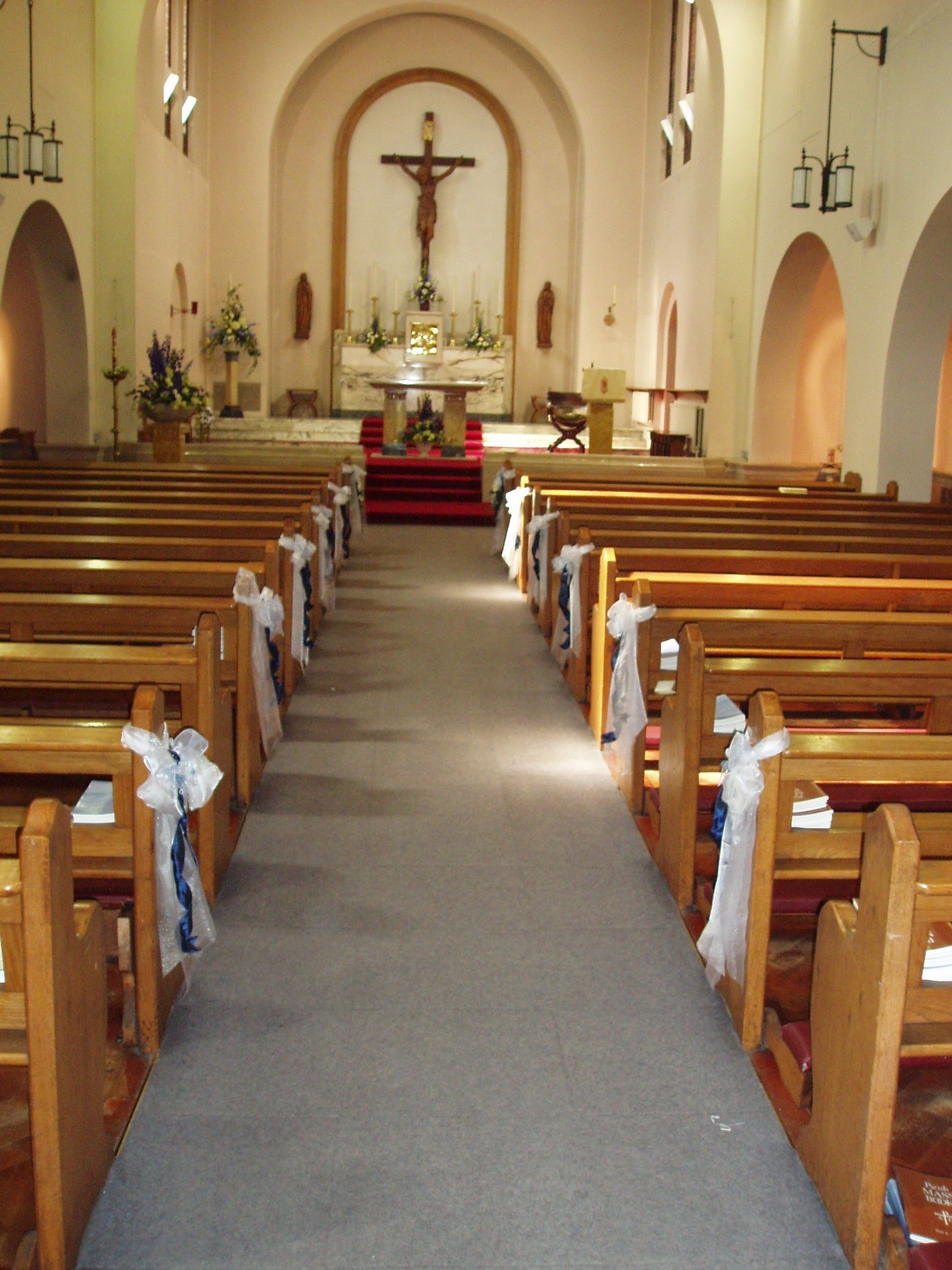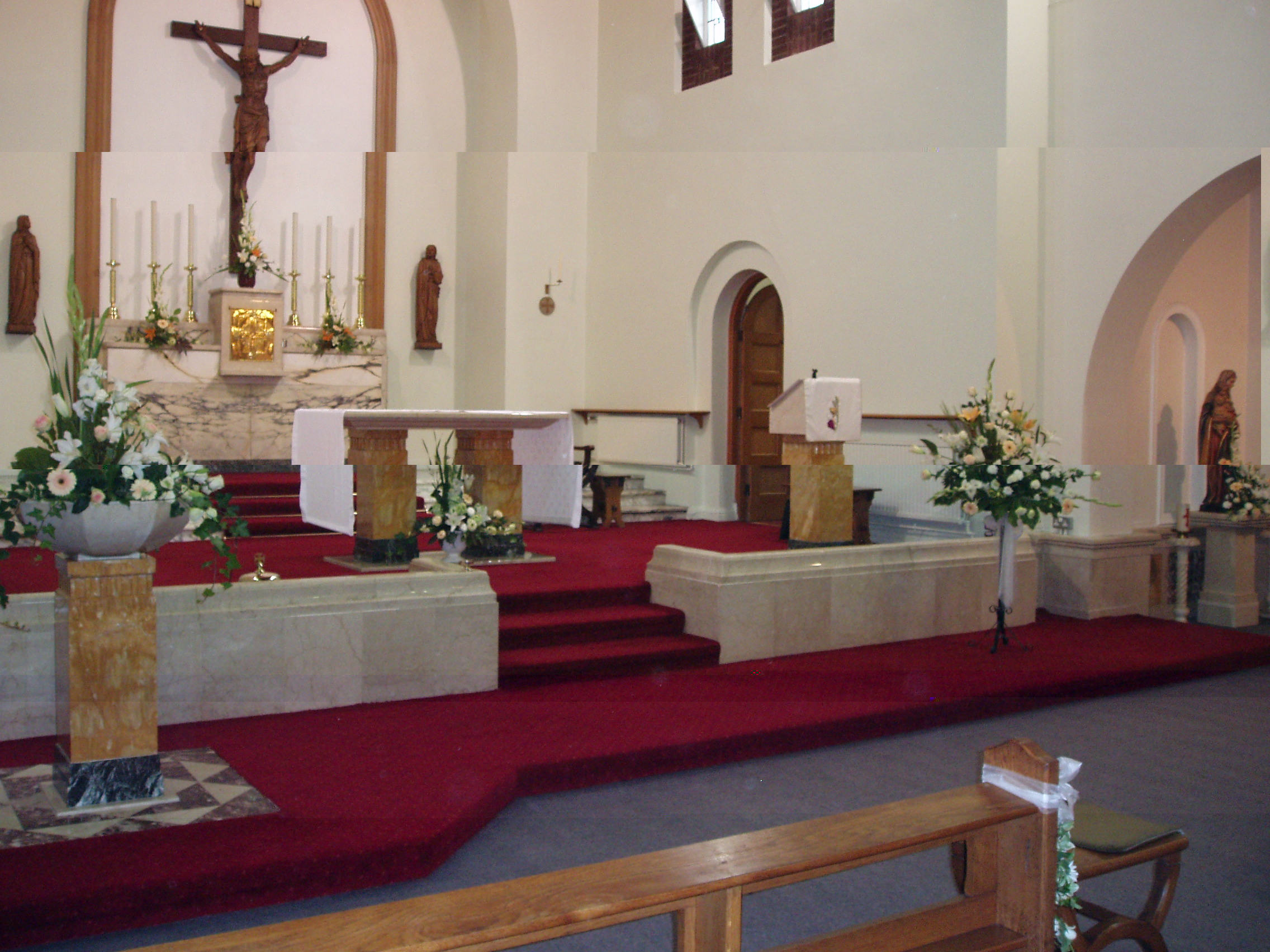
Church History
The following notes give a very short introduction to the History of the
parish. The source of the information is a very interesting book called
"A History of the Parish of Our Lady & St John, Heswall" by Virginia
Bowes. A copy is available in the Church for more detailed
reference.
The 'Tin' church
The first church (temporary chapel) was an ex-army hut affectionately known as the 'tin church' or 'Tin Tabernacle' and was in use from 1920. It was erected where the present church is but higher up the hill.
Prior to this, in 1914, Sunday Mass was said in Lower Heswall, in the ballroom annex of the Victoria Hotel, and at times in the tea-room in the garden of 'Tithe barn', a small-holding in Lower Heswall Village. By 1916 a more accessible centre had been found, namely, the King's Hall Cinema in Telegraph Road. The Catholic Church Building Fund, Heswall was launched in 1919 to receive donations for the temporary chapel. Although these came mainly from the Catholics of Heswall and Wirral, donations arrived from many parts of the British Isles. Equal in number and generosity were the gifts to furnish the chapel.
When the Catholic population of Heswall topped 300 (the chapel held 170) the decision to found a separate mission was taken in September 1928. At first the parish priest lived in a furnished cottage in the complex adjoining the Methodist Church in Telegraph Road until No. 12 South Drive was bought as a presbytery.
The new parish took shape with weekday Masses at 8.00am and two Sunday Masses and Sunday evening Benediction. The Altar Society was formed as was a Communion Sunday for Schoolchildren on the second Sunday of each month. Catechism classes were established and a children's choir formed. Space did not allow for a permanent baptistry so a portable font was used when required. Financial support for the new mission came from the Poor Mission Fund.
During the 1930's increasing numbers indicated the need for a larger church. Also, in 1938, the Local authorities were ready to begin work on a road widening scheme that was to run right through the middle of the 'tin church'. The people of Heswall, led by their energetic parish priest then proceeded to set up a Diocesan record by building an entirely new temporary church in a fortnight. this second temporary church served the parish until the opening of the present church in November 1939. The following year, the old church was bought and set up as the Mission of Our Lady of Pity in Greasby.
The Building
The building is dominant in its setting, though in close proximity it is not overpowering, partly owing to the warmth of the materials used but more so because of the Romanesque influences in the style of architecture.
Three features make an immediate impact; the tower, the pantiles of the roof and the mosaic tympanum over the main door.
Church in the Community
Spiritual growth cannot be measured, but the disciplines of prayer, observance of ritual, commitment to the parish, to the Church and to God's world are manifestations of the desire for it. The experience of priests and people means that opportunities are presented to encourage a zealous witness to faith.
One especially beautiful custom, and one that adds to the solemnity of the moment, is the ringing of the Tower Bell at the consecration in Sunday Masses, and since 1963 the Midnight Angelus is rung on Christmas Eve.
Societies represented in the parish have included the Knight's of St Columba, the Third Order of St Francis, the Society of St Vincent de Paul (SVP), the Catholic Truth Society and the Society for the Propagation of the Faith.
The war years affected the parish in a number of ways, not least spiritually. A daily Mass Crusade was mounted to pray for victory and peace. Soldiers, sailors and airmen who had been killed, were missing or disabled were also remembered.
Public Institutions (now all closed) once served from the church included the Royal Liverpool Children's Hospital on Telegraph Road, Pensby Convalescent wing of Clatterbridge Hospital and Thingwall Hall, Barnston. The pattern has changes but the care continues for all those in Murrayfield Hospital, Heswall House and Pensall House Old People's Homes, Trepassey, Cloverley, The Grange Nursing Home and Abbeyfield Residential homes.
Altar Society
In October 1938, an Altar society was formed to furnish vestments, linen etc for the new church, and on 29th October 1939 an exhibition of work done by the ladies of the Society was held in anticipation of the opening of the new church on 5th November 1939.
The dignity and reverence associated with the altar has been upheld also by those who have assisted the parish priest in the training of acolytes, helping to arrange services and acting as Master of Ceremonies.
Music
There is a history of music in the church as far back as 1928 when a children's choir was formed. Very soon after, the tradition of the sung Mass was established and a choir sang in the 'Tin' church, in a red-curtained recess to the left of the door. In the intervening years, the choir has maintained its high standard. The addition of an organ in 1939 (donated on the opening of the church), enhanced the musical dimension. The current organ was purchased in 1984.<Back to top >
Children
The responsibility to provide for the teaching of Catholic doctrine was fulfilled by holding classes, the first of which was held in October 1928. A children's choir was also formed in December 1928. First Communion was first held in June 1930 and the first Confirmations were held in October 1932. It was always of concern that children followed the Mass and in 1943 the first three rows of the church, on the Gospel side, were reserved for children at the first Mass on Sundays and Holydays.
The parish priests have always had the much valued assistance of voluntary teachers to cover the children's liturgy and catechetical work. For a period between 1945 and 1976 much of this teaching was done by the F.C.J. nuns from Upton Convent. Now the church once again relies solely on voluntary teachers.
Parish School – Ladymount
After the opening of the new church in 1939 there was a strong desire to have a school designated to the parish. Children were being taught in the old church, in the Parish Hall (Church of the Good Shepherd, Telegraph Road) and at Moorland House, Hillside ( a long established boys preparatory school). Others attended Catholic schools in Birkenhead, Upton and Neston. The post war years saw initial plans for a one form entry primary school in the Heswall and Greasby area to accommodate the Catholic children. Eventually these plans were increased to see the building of three such schools - St Winefride's in Mellock Lane, Little Neston, Ladymount in Heswall and Our Lady of Pity in Greasby. However, it was not until the late 1960's did the pace quicken for a primary school in Heswall and much fundraising took place. Ladymount (the name was inspired from Our Lady of Mount Carmel) finally opened on 26th April 1971 and the first Mass in thanksgiving, celebrated in the school on its Patron's feast, established a tradition. In April 1976 the building of a chapel was begun - an extension of the school hall, which for many years was used weekly as a church.
3rd Heswall Scouts (Our Lady & St John)
The first meeting was held on 3rd April 1950. At first the meetings were held in the Scout Hut, 1st Heswall in Sandy Lane, but by August 1965 the Group had moved into its current headquarters in Marks Way, Pensby. The Group has two sponsors - Our Lady & St John, Heswall and Holy Family, Pensby making it unique in the Shrewsbury Diocese. It's colours are yellow and white. The Scout Group comprises Beavers, Cubs and Scouts.
The Scout Group has been most active and successful in the intervening years and is flourishing today. One part of their growth included sponsorship; for approximately 18 months the 3rd Heswall sponsored the Methodist Scout Group which in September 1981 became the 5th Heswall with an all yellow neckerchief (taking yellow as a compliment to 3rd Heswall).
2nd Heswall Brownieswas formed in 1967/8 with the 2nd Heswall Guides forming in December 1970. 1st Pensby Brownies was formed in 1985.
Fund Raising
Fund raising is a burden of all. The original Church Building Fund's burden increased when the Mission became a separate parish in 1928 and a house was bought in 1929 to serve as a presbytery. Our Lady & St John's contribution to the social round in Heswall and district cannot be overestimated especially as the period was a formative one. A new community was developing in the blend of village and town which was rapidly becoming a dormitory for those who worked in Birkenhead and Liverpool, hence the importance of parish and club.
Regular collections were taken for the church debt either post communion or at the church door. Also the seasons provided fund raising opportunities - the Christmas Draw, the St Patrick's Ball, The Women's Guild Fancy Fair and Flannel Dance and the New Year's Eve party. Then there were the jumble sales, weekly whist drives and sometimes a dance. Each event involved little expense and provided a small but regular income, and in catering for different tastes a community spirit was fostered. Each fund raising event was in itself a commentary on the way society as a whole was moving - becoming less formal as befitted the occasion and the time, namely those years known as The Depression.
In the intervening years the parish has striven to raise funds to cover the building expenses of both church and subsequently school.
Parish Priests of Our Lady & St John
|
Canon Stephen Coonan |
2014 - |
Photos of the church



